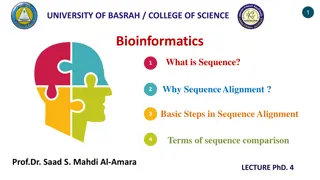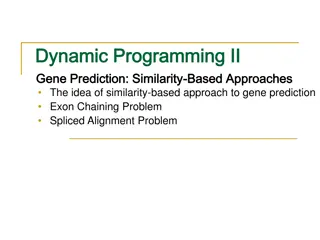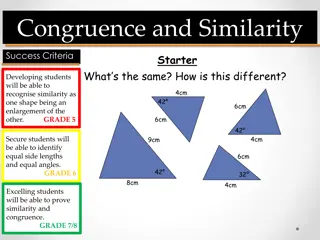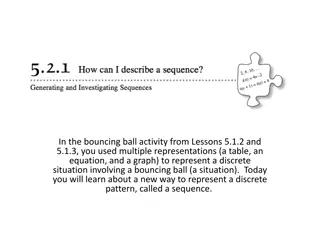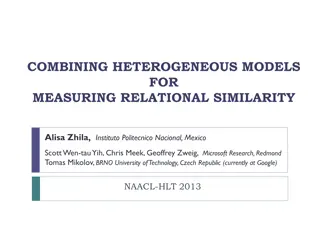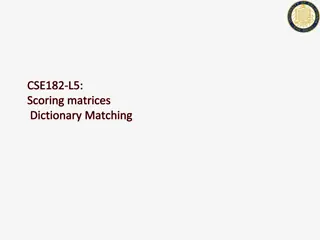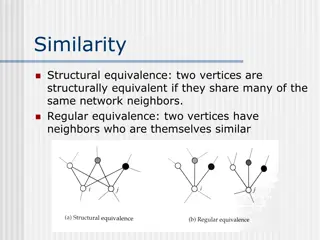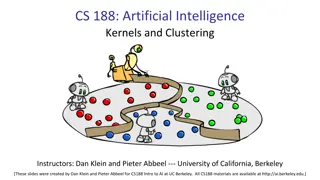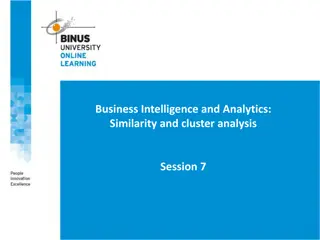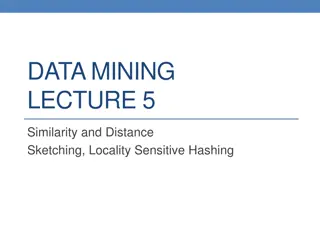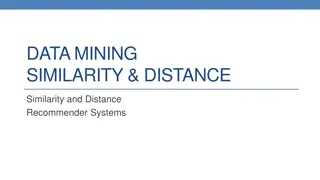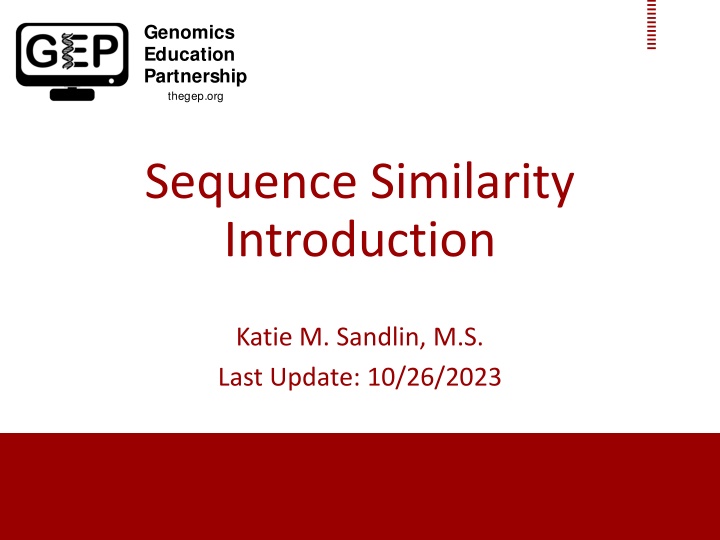
Exploring Sequence Similarity in Bioinformatics
Delve into the world of bioinformatics to understand the concept of sequence similarity, alignment of biological molecules, and the use of tools like BLAST. Learn how to define, quantify, and interpret similarity between DNA and protein sequences, along with exploring non-biological similarities in this comprehensive exercise.
Download Presentation

Please find below an Image/Link to download the presentation.
The content on the website is provided AS IS for your information and personal use only. It may not be sold, licensed, or shared on other websites without obtaining consent from the author. If you encounter any issues during the download, it is possible that the publisher has removed the file from their server.
You are allowed to download the files provided on this website for personal or commercial use, subject to the condition that they are used lawfully. All files are the property of their respective owners.
The content on the website is provided AS IS for your information and personal use only. It may not be sold, licensed, or shared on other websites without obtaining consent from the author.
E N D
Presentation Transcript
Genomics Education Partnership thegep.org Sequence Similarity Introduction Katie M. Sandlin, M.S. Last Update: 10/26/2023
Bioinformatics Involves the use of computers to store, retrieve, analyze, and compare the composition of biological molecules, specifically DNA and protein sequences
Bioinformatics Bioinformatic tools allow scientists (including YOU!) to access the abundant genomic and protein sequences that are available in databases via the internet. Photo: Huge monitor meme generator
Overview Many of the tools used in bioinformatics (e.g., BLAST) are based on the ability to searchfor either nucleotide or amino acid sequences that share some degree of similarity. In this exercise, you will be introduced to the idea of similarity and the alignment of amino acid and nucleotide sequences.
Objectives After completing this exercise, you should be able to: 1. Define similarity in a non-biological and biological sense. 2. Quantify the similarity between two sequences. 3. Explain how a substitution matrix is used to quantify similarity. 4. Calculate amino acid similarity scores using the BLOSUM 62 substitution matrix. 5. Explain how BLAST detects similarity between two sequences. 6. Explain how to use BLAST and interpret the alignments.
Q1. Investigation of Similarity What do we mean when we describe two objects as being similar?
Q2. Investigation of Similarity Are these objects similar? If so, in what way(s) would you consider them to be similar? Matthias Kabel, CC BY-SA 3.0, via Wikimedia Commons. Andre Karwath, CC BY-SA 2.5, via Wikimedia Commons.
Similarity Defined as a resemblance or likeness; related in appearance or nature; or having a corresponding aspect or feature.
Similarity In addition to obvious similarities among objects with the same function, written works can also display similarity. oWhen two passages are highly similar, it is considered plagiarism. This implies a common origin to the passages (i.e., the second passage was copied from the first).
Q3. How could the similarity between these two passages be quantified? What must be done prior to determining the similarity of these passages? Passage 1 One fish, two fish, red fish, blue fish. Black fish, blue fish, old fish, new fish. This one has a little star. This one has a little car. Say! what a lot of fish there are. Passage 2 One sheep, two sheep, black sheep, blue sheep. Red sheep, blue sheep, old sheep, new sheep. This one has a little bell. That one drank from a well. Wow! what loads of sheep there are. Dr. Seuss, 1960
Similarity in Bioinformatics Excessive" (i.e., more than one would expect based on chance) amount of physical similarity between two organisms implies a common ancestry oThis implication also holds true for biological sequences. Shared ancestry between two organisms or sequences is known as homology.
Similarity in Bioinformatics It is important to note that sequence similarity does not always ensure sequence homology, but that sequence similarity is an expected consequence of homology.
Homology Similarities to the mouse gene (Pax6) are highlighted in green. https://evolution.berkeley.edu/why-the-eye/homologous-genes/
Identifying Similarity Imagine that you have identified a new gene or protein. What questions might you be asking? oWhat is the function of this protein? oWhat type of protein is encoded by this gene? A first step in answering these questions would likely include a search of nucleotide and/or protein databases for a known gene or protein that is similar to your recently identified sequence.
Identifying Similarity A search of these databases is based on finding a sequence that can be aligned with your sequence of interest and then the similarity of the sequences can be calculated using a suitable scoring matrix.
Scoring Similarity Several scoring matrices for amino acid sequence comparisons (e.g., BLOSUM, PAM) have been developed by scientists. These matrices take into account the substitution of chemically and/or physically similar amino acids and the relative frequency of such substitutions in naturally occurring proteins.
Q4. Considering amino acid residue chemical properties, explain why an Alanine substituted with a Serine is assigned a score of 1, while an Alanine substituted with a Tryptophan is assigned a score of -3 in the BLOSUM 62 substitution matrix.
Scoring Similarity How positive or negative a substitution score is depends on the relative similarity in residue chemical properties. BLOSUM 62 is a commonly used substitution matrix.
Query: MGDVEKGKKIFIMKC Subject: MGEVERGKKLFIMKC
What is the total similarity score for these two aligned sequences? oQuery: MGDVEKGKKIFIMKC oSubject: MGEVERGKKLFIMKC
Finish Questions 6-9 Read the text on pages 6-8
Query Word Query Sequence: R P P E G L F Database Sequence: D P P E G V V Score: -2 7 7 5 6 1 -1 Optimal Accumulated Score = 7 + 7 + 5 + 6 + 1 = 26 What s our query word (i.e., scan for an exact match that is 3 amino acids long)?
Query Word Query Sequence: R P P E G L F Database Sequence: D P P E G V V 5 7 6 Score: Score: -2 7 7 5 6 1 -1 Optimal Accumulated Score = 7 + 7 + 5 + 6 + 1 = 26
Query Word Query Sequence: R P P E G L F Database Sequence: D P P E G V V Score: -2 7 7 5 6 1 -1 Optimal Accumulated Score = 7 + 7 + 5 + 6 + 1 = 26
Calculate Total Score 23 0 19 19 25
Caveat Negative substitution values may not terminate the extension process as long as the total alignment score is above a user defined value. oWe must also deal with gaps in the alignment. For more information on this see Introduction to Dynamic Programming.
Basic Local Alignment Search Tool (BLAST) BLAST finds regions of local similarity between nucleotide or protein sequences oby comparing nucleotide or protein sequences to sequence databases (or to an individual nucleotide or protein sequence) ocalculates the statistical significance of each match
Exercise 1 Complete the Computational Procedure for the Protein BLAST. Answer Q10-12.
Q11. What was the query for this search? What species database did you search for a hit to the query?
Q12. If we were to compare the nucleotide sequences for the gene encoding this protein between humans and chimps, do you think they would be identical? Explain.
Exercise 2 Complete the Computational Procedure for the Nucleotide BLAST. Answer Q13-15.



